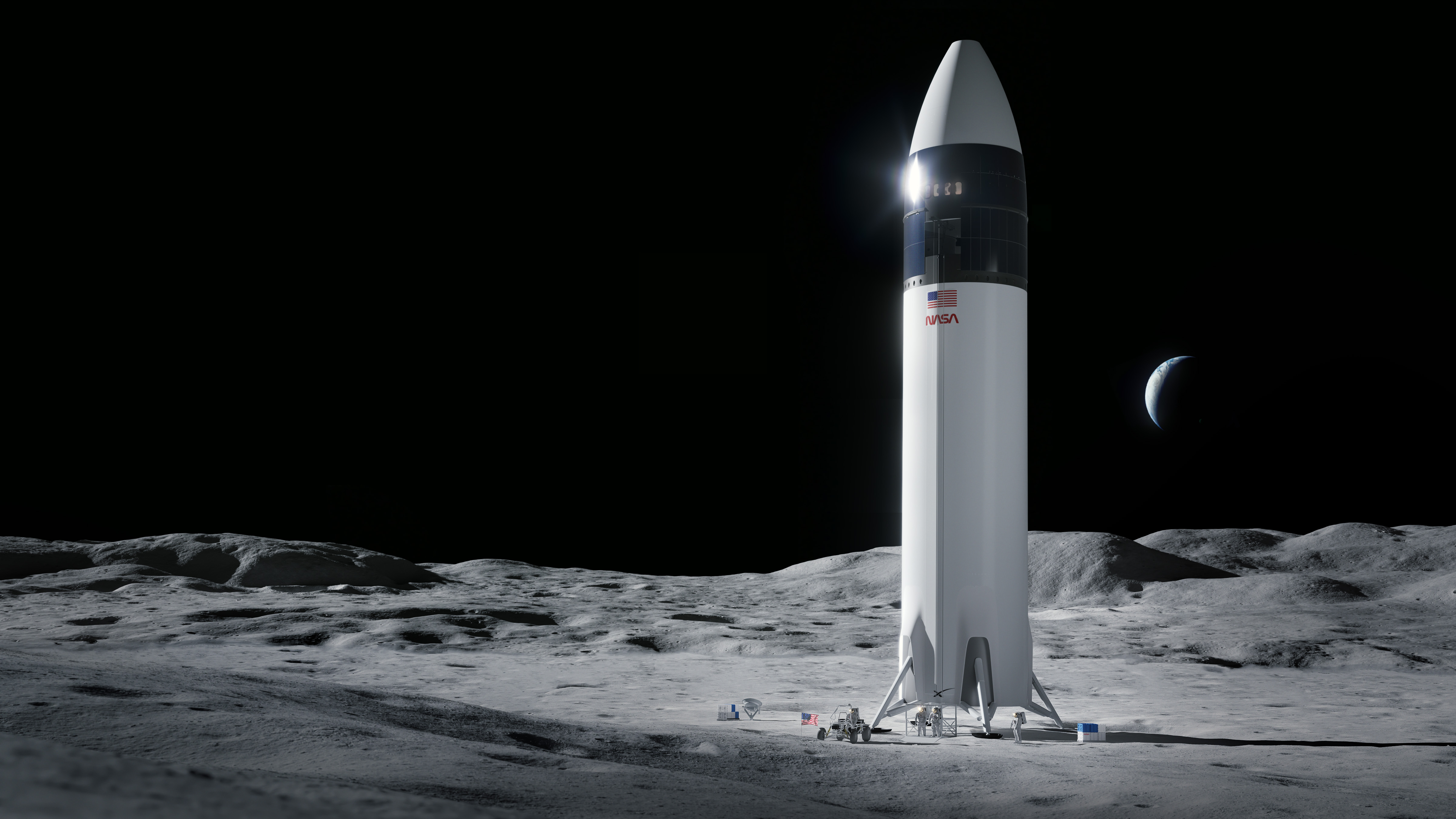
The United States' next moonshot is shaping up to be a contentious affair.
In mid-April, NASA awarded SpaceX a $2.9 billion contract to finish development of its Starship vehicle and fly two missions with it to the lunar surface for the agency's Artemis program. If all goes according to plan, the second of those missions will put two astronauts down near the lunar south pole in the mid-2020s — the first crewed moon landing since Apollo 17 in 1972.
SpaceX, founded by billionaire Elon Musk, beat out two commercial competitors for the lunar lander deal — Dynetics and the "National Team," which is led by Blue Origin, a spaceflight company owned by billionaire Jeff Bezos. But those two groups didn't accept the decision and move on. They both filed protests with the U.S. Government Accountability Office (GAO) in late April, citing perceived flaws in the award process. NASA has held up the $2.9 billion until the GAO finishes an investigation into the matter, which will wrap up by early August.
Related: NASA unveils plan for Artemis 'base camp' on the moon beyond 2024
A chief complaint of both protests was the fact that NASA selected just one company, after the space agency had said it aimed to pick at least two at this stage to maintain competition and redundancy. And the passage of a month doesn't seem to have softened this objection, for Blue Origin aired it again, in a very public fashion, on Thursday (May 27).
"The Human Landing System program needs competition, not the delay of starting over. The National Team has an open architecture, deep experience, massive self-funded investments and a safe, low-risk design to return to the moon. Let's go. #Artemis," the company said via its official Twitter account Thursday.
The billionaire space rivalry continues
There are many layers to the lunar lander kerfuffle. For example, it involves the two richest people on the planet — Bezos and SpaceX CEO Musk — who have sparred at times over their companies' accomplishments and capabilities.
Get the Space.com Newsletter
Breaking space news, the latest updates on rocket launches, skywatching events and more!
In November 2015, for instance, the first-stage rocket of Blue Origin's reusable New Shepard suborbital vehicle successfully landed during a flight test — something that SpaceX had been trying to achieve during orbital missions with its Falcon 9 rocket.
Musk congratulated Bezos at the time but also took a bit of a swipe, stressing that landing the first stage of an orbital launcher is a much more challenging task. Bezos pushed back, saying that the Falcon 9 first stage never makes it to orbit, and that New Shepard may actually face a more challenging re-entry environment. (SpaceX landed a Falcon 9 booster for the first time in December 2015, the month after Blue Origin's feat, and has repeated the feat many, many times since. New Shepard has also aced additional landings and is getting set to fly its first customer this summer.)
In April 2019, Musk called Bezos a "copycat" after Amazon revealed that it intends to assemble a constellation of thousands of internet satellites. SpaceX is building its own broadband network, called Starlink, and launched the first test spacecraft for the constellation in February 2018. The company has lofted more than 1,600 Starlink satellites to date and is providing service now, in the beta-testing phase.
Then, in May 2019, the SpaceX chief trolled Bezos over Blue Origin's newly unveiled lunar lander, a robotic vehicle called Blue Moon. Musk tweeted an altered photo of the lander that showed its name as "Blue Balls" and wrote, "Oh stop teasing, Jeff," with a winky-face emoji.
The New York Times' Kenneth Chang broke the news of The National Team's protest on April 26 of this year. Chang tweeted his story out that day, and Musk quickly replied with a tweet that matched the tone of his "Blue Balls" offering: "Can’t get it up (to orbit) lol."
That's an apparent reference to Blue Origin's New Glenn orbital rocket, which has yet to make its spaceflight debut.
And the recent Artemis contract didn't mark the first time that SpaceX beat Blue Origin out for a lucrative deal. In August 2020, the Department of Defense selected SpaceX and United Launch Alliance (ULA) as its two primary launch providers for the near future, going with SpaceX's Falcon 9 and Falcon Heavy rockets and ULA's new Vulcan Centaur.
The two companies bested Blue Origin and Northrop Grumman, which had offered up their New Glenn and OmegA boosters, respectively. (Blue Origin will still get a piece of that money, however; the company makes the BE-4 engines that will power Vulcan Centaur's first stage.)
Related: See the evolution of SpaceX's rockets in pictures
Senators get involved
NASA, for its part, didn't want to pare the Artemis crewed lander pool down to one participant at this stage. Agency officials have stressed that this was basically their only option, because Congress has not allocated enough money to spread among two different lander projects.
That situation could change. Sen. Maria Cantwell (D-Wash.), who chairs the Senate Commerce, Science and Transportation Committee, recently added an amendment to the already sprawling Endless Frontier Act that calls for NASA to get an additional $10 billion for the Artemis Human Landing System.
The amendment invokes the need for competition as a pure and basic good. But the fact that Cantwell represents Blue Origin's home state — the company is based in the Seattle area — has raised both eyebrows and objections.
For example, Sen. Bernie Sanders (I-Vermont) — a frequent critic of Bezos and billionaires in general — quickly submitted another amendment to the Endless Frontier Act, with the following stated purpose: "To eliminate the multi-billion dollar Bezos Bailout."
Sen. Bernie Sanders is jumping into NASA's lunar lander fiasco with an amendment that deletes the whole human landing system section from the NASA authorization bill"Purpose: To eliminate the multi-billion dollar Bezos Bailout" pic.twitter.com/cTdVb44E4iMay 24, 2021
It's unclear at the moment whether all of this drama — the sniping, the protests filed by Dynetics and The National Team and the dueling amendments — will actually change the Artemis funding landscape. And we'll have to wait a while to find out.
The GAO's findings aren't due until Aug. 4, after all. The Senate appears set to pass the Endless Frontier Act, a $195 billion bill aimed at boosting American technological competitiveness. But, as Ars Technica's Eric Berger pointed out, the bill must still make its way through the U.S. House of Representatives, which could strip away some of its amendments in the process.
The effect on Starship's development is tough to gauge as well. SpaceX would certainly like to get its hands on the Artemis money, but the company has been building and testing the next-gen deep-space vehicle with internal funding for years now. And the project recently notched a huge milestone — the first successful landing after a high-altitude flight test, which the SN15 Starship prototype pulled off on May 5.
Starship is a huge priority for Musk, who has repeatedly stated that he founded SpaceX in 2002 primarily to help make humanity a multiplanet species. He believes that the reusable Starship will turn that vision to reality, with some stops at the moon along the way.
Mike Wall is the author of "Out There" (Grand Central Publishing, 2018; illustrated by Karl Tate), a book about the search for alien life. Follow him on Twitter @michaeldwall. Follow us on Twitter @Spacedotcom or Facebook.
Join our Space Forums to keep talking space on the latest missions, night sky and more! And if you have a news tip, correction or comment, let us know at: community@space.com.

Michael Wall is a Senior Space Writer with Space.com and joined the team in 2010. He primarily covers exoplanets, spaceflight and military space, but has been known to dabble in the space art beat. His book about the search for alien life, "Out There," was published on Nov. 13, 2018. Before becoming a science writer, Michael worked as a herpetologist and wildlife biologist. He has a Ph.D. in evolutionary biology from the University of Sydney, Australia, a bachelor's degree from the University of Arizona, and a graduate certificate in science writing from the University of California, Santa Cruz. To find out what his latest project is, you can follow Michael on Twitter.
